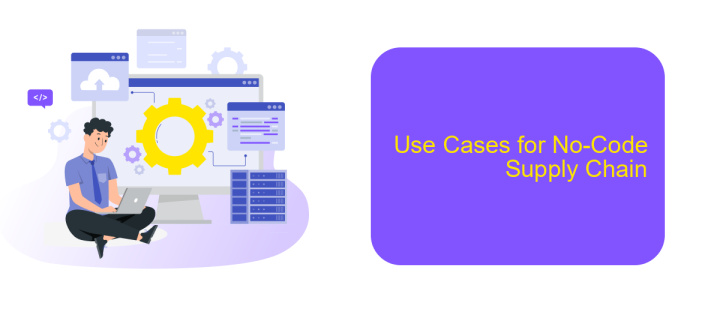No-Code Supply Chain
The rise of no-code platforms is revolutionizing the supply chain industry by enabling professionals to create and manage complex workflows without any programming knowledge. These user-friendly tools streamline operations, reduce costs, and enhance efficiency. In this article, we explore how no-code solutions are transforming supply chain management, offering unprecedented flexibility and agility to businesses of all sizes.
Introduction
The advent of no-code platforms has revolutionized various industries, and supply chain management is no exception. No-code tools enable businesses to streamline their supply chain processes without the need for extensive coding knowledge. This democratization of technology allows even non-technical staff to create, automate, and manage complex workflows efficiently.
- Enhanced operational efficiency through automation
- Cost reduction by minimizing the need for specialized IT staff
- Improved agility and faster response to market changes
- Seamless integration with existing systems
One such tool that facilitates the integration of various supply chain components is ApiX-Drive. This service allows businesses to connect different applications and automate data transfer between them, ensuring seamless operations. By leveraging no-code platforms like ApiX-Drive, companies can achieve more efficient supply chain management, leading to increased productivity and reduced operational costs.
Benefits of No-Code Supply Chain

No-code supply chain solutions offer numerous benefits, making it easier for businesses to streamline their operations without the need for extensive programming knowledge. By leveraging no-code platforms, companies can quickly adapt to changing market demands, reduce operational costs, and increase overall efficiency. These solutions empower non-technical staff to create and modify workflows, thus accelerating the implementation of new processes and reducing dependency on IT departments. This democratization of technology enables faster decision-making and enhances agility in responding to supply chain disruptions.
One of the key advantages of no-code supply chain solutions is the ease of integration with existing systems and applications. Services like ApiX-Drive facilitate seamless connections between various software platforms, allowing for real-time data synchronization and improved visibility across the supply chain. This integration capability ensures that all stakeholders have access to accurate and up-to-date information, fostering better collaboration and informed decision-making. Ultimately, the adoption of no-code tools can lead to a more resilient and responsive supply chain, capable of meeting the demands of a dynamic business environment.
Challenges of No-Code Supply Chain

Implementing a no-code supply chain can significantly streamline operations, but it also comes with its own set of challenges. One of the primary concerns is the integration of various systems and data sources. Without proper integration, the flow of information can become fragmented, leading to inefficiencies and errors.
- Data Security: Ensuring the security of data across multiple platforms is crucial. No-code solutions must adhere to stringent security protocols to protect sensitive information.
- Customization Limits: While no-code platforms offer flexibility, they may not provide the level of customization needed for complex supply chain operations. This can limit the ability to tailor solutions to specific business needs.
- Integration Complexity: Seamlessly integrating various tools and systems can be challenging. Services like ApiX-Drive can simplify this process by providing easy-to-use integration solutions, but it still requires careful planning and execution.
- Scalability: As businesses grow, their supply chain needs become more complex. No-code solutions must be scalable to adapt to increasing demands without compromising performance.
Despite these challenges, the benefits of a no-code supply chain, such as reduced development time and increased agility, make it a compelling option for many businesses. By leveraging tools like ApiX-Drive for integrations, companies can overcome some of the hurdles and achieve a more efficient and responsive supply chain.
Use Cases for No-Code Supply Chain

No-code platforms are revolutionizing supply chain management by enabling businesses to quickly adapt to changing demands and streamline operations without the need for extensive coding knowledge. These platforms empower users to create custom applications and automate workflows, enhancing efficiency and reducing costs.
One of the primary use cases for no-code supply chain solutions is inventory management. By leveraging no-code tools, companies can build applications to track stock levels, set up automatic reorder triggers, and generate real-time inventory reports. This ensures that businesses maintain optimal stock levels and avoid overstocking or stockouts.
- Order processing: Automate order processing workflows to reduce manual errors and speed up fulfillment times.
- Supplier management: Create custom portals for supplier communication and performance tracking.
- Logistics optimization: Develop applications to monitor and optimize shipping routes and delivery schedules.
- Integration with existing systems: Use services like ApiX-Drive to seamlessly connect various supply chain software and tools.
In addition to these use cases, no-code platforms like ApiX-Drive facilitate the integration of disparate systems, allowing for a more cohesive and efficient supply chain. By automating data transfers and synchronizing information across platforms, businesses can achieve greater visibility and control over their supply chain operations.
- Automate the work of an online store or landing
- Empower through integration
- Don't spend money on programmers and integrators
- Save time by automating routine tasks
Future Outlook for No-Code Supply Chain
The future of no-code supply chain solutions looks promising as businesses increasingly seek agility and efficiency in their operations. With the ability to quickly adapt to changing market conditions, no-code platforms empower organizations to design and implement supply chain processes without the need for extensive IT involvement. This democratization of technology allows for faster innovation and reduces the time-to-market for new products and services. As companies continue to prioritize digital transformation, no-code solutions will play a crucial role in streamlining supply chain management and enhancing overall productivity.
One of the key drivers of this trend is the growing availability of integration services like ApiX-Drive, which simplifies the process of connecting various applications and systems. By leveraging such tools, businesses can create seamless workflows and automate data exchange across their supply chain networks. This not only reduces manual efforts but also minimizes the risk of errors, leading to more accurate and reliable operations. As the no-code ecosystem evolves, we can expect even more sophisticated solutions that will further optimize supply chain processes and drive sustainable growth.
FAQ
What is No-Code Supply Chain?
How can No-Code platforms benefit supply chain management?
Can No-Code platforms integrate with existing supply chain systems?
Is it possible to automate supply chain workflows without coding skills?
What are some examples of tasks that can be automated in a No-Code Supply Chain?
Time is the most valuable resource in today's business realities. By eliminating the routine from work processes, you will get more opportunities to implement the most daring plans and ideas. Choose – you can continue to waste time, money and nerves on inefficient solutions, or you can use ApiX-Drive, automating work processes and achieving results with minimal investment of money, effort and human resources.


